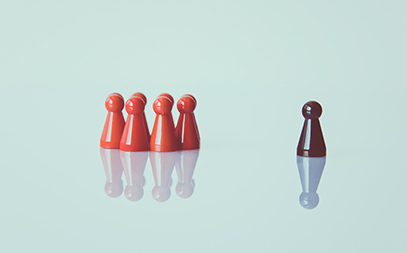Social Exclusion
and what it leads to

Exclusion
Exclusion and more specifically social exclusion stems from the denial of recognition on the part of a group of people of ‘the other or others’ exactly due do his/her alterity...
what is social exclusion
Generally I don’t like definitions.
In definitions, you always omit or forget something really, really important. There’s always aspects that are are left outside. Nonetheless, we have to set a framework into which we can understand the concept of exclusion.
So we can start by saying that exclusion is a multidimensional issue. It has a moral, ideological, social and institutional / legal dimension.
Exclusion, basically it starts from a moral perception that understands the different other, as someone that cannot should not be recognised by a community, but any community that understands itself as such. This other can be an individual or can be a group.
Moreover, exclusion is an ideological principle that is internalised in the values and belief systems of people, and it’s performed through the judgments and actions.
Exclusion threatens mainly those who can be considered as vulnerable, it…
…basically, threatens the vulnerable other. This vulnerable other is someone who usually, not always, but in most cases, is one who is in first of all different and B is an an inferior power position towards the dominant community.
Exclusion is historically determined in the sense that it takes different forms in different societies and in different historical periods. For example, you have…
…The ancient Greek community, the polis, from which the woman and the slave is excluded. For example, you have the mediaeval community into which the disabled or the mentally ill or the leper is excluded.
Nowadays we live in a far more complex society, so the picture of the vulnerable other has changed as well. It is more subtle, but nonetheless even more ubiquitous.
We can say that we have reached a level of moral maturity where we do not hide the vulnerable other anymore simply possibly because we cannot do that. It’s everywhere ,our societies has changed, they’re multicultural and in a sense, multiethnic.
Therefore, the vulnerable other has changed. Now exclusion occurs through gender, through ethnic origin, through sexual orientation, etcetera etcetera etcetera. Now one thing we should also understand is that…
…Exclusion does not…
…Happen at some points of society. It happens everywhere. It occurs everywhere at the macro level, which is the society in general.
For example, we have cases of legalised exclusion. One can think only of the apartheid.
All the racial segregation laws that existed in the USA until the 60s.
Also, we have at the Meso level. For example, we can have a school to come to our context that uses exclusionary practises or in the micro level which is the classroom where the person who’s excluding can be the teacher or…
…the children themselves. In this sense, and to go back to the ideological aspect that we said, one can speak of an exclusive mentality.
what social exclusion leads to
What can social exclusion lead to? There is a saying like a horse can save a soldier. A soldier can save a battle and a battle can save a land and from this perspective a simple exclusion can cause a breakdown in a class, in a school, in a society or community…
…And it goes and goes like that. Peer bullying, early school leaving and unemployment in later phases can be some of the certain results of exclusion.
Actually, it’s something like knitting. When you miss a single knot, you will not be able to knit anymore.
And when one student or one person is excluded, it will not be the same as it was before. You should tie the knots and keep knitting.
And as teachers, we have the power to tie the knots, and we have the power to turn exclusion into inclusion because no one…
…deserves to feel excluded. Thank you.
Example of Exclusion
While social exclusion can be found in every phase of life, we encounter it at schools and social exclusion at schools refers to the lack of connectedness and participation from a peer group.
Students can easily exclude 1 member of the class and name him or her as the other.
It’s maybe because of his or her ethnicity and religion, economical status, family issues…
…Or even in the case of success or failure.
But humans are social creatures. They need to be able to communicate with others and need to be a part of a social group, especially at a younger age.
And it’s crucial for a healthy mental development. And to foster this development, we as teachers are the ones who have the biggest responsibility to include these students.
In that case…
…we are not trying to make all those students in one colour, we don’t want to see them as orange as yellow.
Our main aim is to create a nice rainbow like all the colours in harmony. They are different but excellent in many ways. Thank you.
